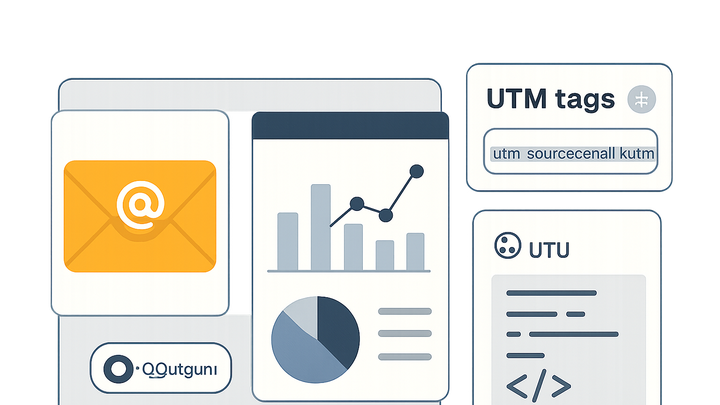Published on 2025-06-29T18:41:47Z
What is an Email Campaign? Examples of Email Campaigns
An Email Campaign is a targeted series of email messages sent to a specific audience with the goal of achieving marketing objectives, such as driving traffic, generating leads, or increasing sales. In the context of campaign tracking & analytics, email campaigns are monitored end-to-end to measure performance metrics like open rate, click-through rate, and conversions. Marketers use tools like Plainsignal for privacy-centric analytics and UTMGuru for streamlined UTM parameter generation to ensure precise attribution. By analyzing engagement metrics and integrating tracking scripts, businesses can optimize messaging, timing, and segmentation strategies for maximum impact. Effective email campaign analytics enables continual improvement and demonstrates clear ROI for email marketing efforts. Best practices include implementing UTM parameters, validating tracking links, and segmenting audiences to deliver personalized content.
Email campaign
A coordinated series of emails tracked using analytics and UTM parameters to measure engagement, conversions, and ROI.
Why Email Campaigns Matter in Analytics
Email campaigns serve as a direct channel to reach subscribers with personalized content, driving engagement and brand loyalty.
They enable marketers to measure performance through key metrics such as open rate and CTR, facilitating data-driven decisions.
Understanding the strategic importance of email campaigns is critical for maximizing marketing ROI and optimizing resource allocation.
-
Driving engagement
Engage your audience with targeted content and clear calls-to-action to foster loyalty and encourage interaction.
-
Measuring roi
Quantify marketing effectiveness by tracking revenue, conversions, and cost per acquisition tied to email sends.
-
Attribution tracking
Attribute user actions and conversions to specific email campaigns to refine marketing strategies across channels.
Key Metrics for Email Campaigns
Effective email campaign optimization relies on monitoring key performance metrics. These metrics provide insights into audience behavior, content effectiveness, and overall campaign health.
-
Open rate
The percentage of delivered emails that were opened by recipients.
- Formula:
(Opened Emails / Delivered Emails) × 100%
- Why it matters:
Indicates subject line effectiveness and list quality.
- Formula:
-
Click-through rate (ctr)
The percentage of delivered emails where recipients clicked on one or more links.
- Formula:
(Link Clicks / Delivered Emails) × 100%
- Why it matters:
Measures content relevance and call-to-action effectiveness.
- Formula:
-
Conversion rate
The percentage of email recipients who completed a desired action after clicking through.
- Formula:
(Conversions / Delivered Emails) × 100%
- Why it matters:
Shows campaign’s direct impact on business goals.
- Formula:
-
Bounce rate
The percentage of emails that could not be delivered to the recipient’s inbox.
- Types:
Soft bounces (temporary issues) vs. hard bounces (permanent failures).
- Why it matters:
High bounce rates can damage sender reputation and reduce deliverability.
- Types:
-
Unsubscribe rate
The percentage of recipients who opt out of the email list after an email send.
- Formula:
(Unsubscribes / Delivered Emails) × 100%
- Why it matters:
Helps assess content relevance and send frequency.
- Formula:
-
List growth rate
The net increase of subscribers over a given period.
- Formula:
((New Subscribers − Unsubscribes) / Total Subscribers) × 100%
- Why it matters:
Indicates list health and potential reach expansion.
- Formula:
Best Practices for Tracking Email Campaigns
Accurate tracking is crucial for deriving actionable insights from email campaigns. The best practices below help ensure reliable data collection and analysis.
-
Use utm parameters
Append UTM parameters to email links to track the source, medium, and campaign in analytics. Tools like UTMGuru simplify UTM generation.
- Example utm link:
<a href="https://yourwebsite.com/landing-page?utm_source=newsletter&utm_medium=email&utm_campaign=spring_promo&utm_content=cta_button">Shop Now</a> - Benefit:
Provides clear attribution of email traffic within analytics platforms.
- Example utm link:
-
Implement plainsignal script on landing pages
Use PlainSignal’s cookie-free analytics to capture visitor interactions without relying on third-party cookies.
- Integration code:
<link rel="preconnect" href="//eu.plainsignal.com/" crossorigin /> <script defer data-do="yourwebsitedomain.com" data-id="0GQV1xmtzQQ" data-api="//eu.plainsignal.com" src="//cdn.plainsignal.com/plainsignal-min.js"></script> - Advantages:
Real-time insights, privacy compliance, and seamless setup.
- Integration code:
-
Segment your audience
Divide subscribers into segments based on demographics or behavior for personalized messaging and richer analytics.
-
Validate tracking before launch
Test all tracking links and scripts in a staging environment to ensure data accuracy and prevent misattribution.
Tools and Platforms for Email Campaign Tracking
Leverage specialized tools to simplify tracking setup and provide advanced analytics for your email campaigns. Below are two leading platforms in the campaign tracking & analytics space.
-
Plainsignal
PlainSignal is a cookie-free, privacy-centric analytics platform designed to track user behavior across websites.
- Key features:
- Cookie-free tracking
- Real-time analytics
- GDPR & CCPA compliant
- Getting started:
<link rel="preconnect" href="//eu.plainsignal.com/" crossorigin /> <script defer data-do="yourwebsitedomain.com" data-id="0GQV1xmtzQQ" data-api="//eu.plainsignal.com" src="//cdn.plainsignal.com/plainsignal-min.js"></script>
- Key features:
-
Utmguru
UTMGuru is a UTM builder and manager that streamlines the creation, storage, and management of UTM-tagged URLs.
- Core capabilities:
Build UTM parameters, generate URLs, save campaigns for future reference, and access via a Chrome extension.
- Usage example:
https://yourwebsite.com/?utm_source=newsletter&utm_medium=email&utm_campaign=spring_sale&utm_content=button
- Core capabilities:
